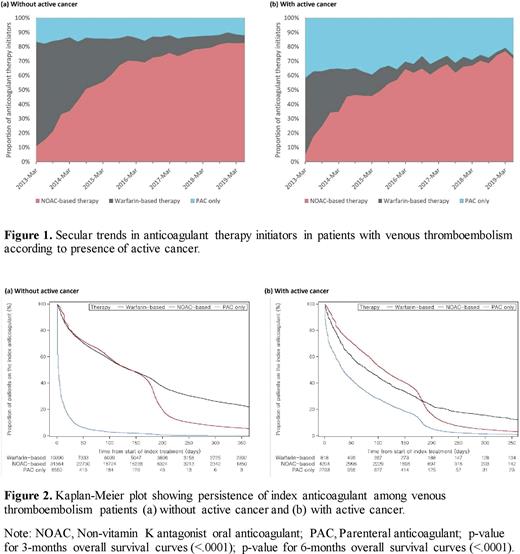Abstract
Background: Contemporary venous thromboembolism (VTE) treatment guidelines for patients with and without active cancer suggested the use of non-vitamin K antagonist oral anticoagulants (NOACs) as an alternative to low molecular heparin (LMWH) and vitamin K antagonist (VKA), respectively. By understanding the current VTE treatment options and changes, we may be able to facilitate better management of VTE patients in Korea.
Purpose: To describe treatment patterns of anticoagulant (AC) therapies among patients with VTE by the presence of active cancer in South Korea.
Methods: Using a nationwide health insurance claims database between March 2012 and December 2019 in South Korea, we constructed an incident, treatment-naïve cohort of adult patients newly diagnosed with VTE and newly initiated AC therapy within 30 days of their VTE diagnosis. The index date, or start of follow-up, was defined as the date of treatment initiation with AC therapy. Index AC therapy was classified into three mutually exclusive groups of: 1) warfarin-based therapy, defined as warfarin only or with parenteral AC (PAC) followed by warfarin within 14 days; 2) NOAC-based therapy, defined as NOAC only or with PAC followed by NOAC within 14 days; and 3) PAC only therapy, defined as the use of unfractionated heparin or LMWH for more than 14 days. Active cancer was defined as the presence of a diagnosis of cancer or prescription of any anti-cancer treatment (with V code; special domestic code given to patients with confirmed diagnosis of cancer) within six months prior to the index date. We explored secular trends in AC therapy according to the presence of active cancer and further, used Kaplan-Meier plots to demonstrate treatment patterns by each AC initiator over time. We also estimated the 3- and 6-month persistence rates of AC therapy to identify the distribution of patients remaining on their index AC therapy, where persistence was defined as having neither experience of treatment interruption, switch, nor discontinuation.
Results: Of 55,759 patients with incident VTE and new users of AC therapy, there were 7,255 and 48,504 patients with and without active cancer, respectively. NOAC-based therapy was the most common AC therapy in both patients with active cancer (n=4,204 [57.9%]) and without active cancer (n=31,564 [65.1%]); warfarin-based therapy (n=818 [11.3%]) and PAC only therapy (n=6,550 [13.5%]) were the least common in patients with and without active cancer, respectively. Moreover, the prescription of PAC only initiators was more than 2-fold higher in patients with active cancer (30.8%) than those without active cancer (13.5%). During the study observation period (2013-2019), there was a steep increase of NOAC-based therapy initiators among patients with VTE, regardless of the presence of active cancer, which contrasts with the relatively plateau trend for PAC only therapy initiators and a sharply declining trend for warfarin-based therapy initiators (Figure 1). Similar trends of persistence were observed in both VTE patients with and without active cancer, given that the highest persistence rates were for NOAC-based therapy at 3-months (with active cancer, n=2,405 [57.2%]; without active cancer, n=19,848 [62.9%]), and warfarin-based therapy at 6-months (with active cancer, n=217 [26.5%]; without active cancer, n=4,393 [42.3%]) (Figure 2). Although treatment switching was most frequent with warfarin-based therapy, which was comparable between patients with active cancer (n=144 [17.6%]) and without active cancer (n=1,541 [14.8%]), the AC therapy to which they switched differed; while the majority of warfarin-based therapy initiators switched to NOAC-based therapy (n=1,470 [95.4%]) in patient without active cancer, only two in three (n=98 [68.1%]) warfarin-based therapy initiators switched to NOAC-based therapy in patient with active cancer. Treatment switchers who initiated NOAC-based therapy mostly switched to warfarin in patients without active cancer (n=1,155 [90.7%]), whereas only half of them switched to warfarin in patients with active cancer (n=84 [48.6%]).
Conclusions: In the current era of NOACs, NOAC-based therapy was predominant in both patients with and without active cancer. However, VTE patients with active cancer were often prescribed with PAC only therapy and showed distinctive treatment patterns when compared to those without.
Disclosures
Choi:Pfizer: Current Employment, Current equity holder in publicly-traded company. Shin:Pfizer: Honoraria; Bristol Myers Squibb: Honoraria.
Author notes
Asterisk with author names denotes non-ASH members.


